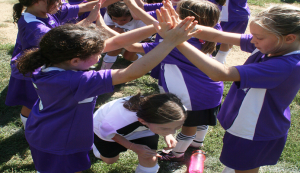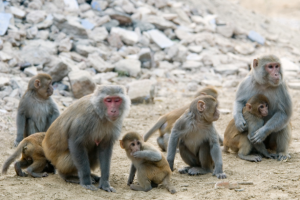Pre-Reading
This reading introduces socialization. It defines it in the following way:
“Socialization is the process through which people are taught to be proficient members of a society. It describes the ways that people come to understand societal norms and expectations, to accept society’s beliefs, and to be aware of societal values.”
Pre-Reading Activity
Discuss the following questions with a partner.
- Who teaches children to be proficient members of a society?
- What are some societal beliefs and values that you have been taught?
- What would happen if a child was never socialized? How might they struggle?
- Look at Figure 1 below. How does the picture relate to socialization?
Reading 1: Introduction to Socialization [1]

In the summer of 2005, police detective Mark Holste followed an employee from the Department of Children and Families to a home in Plant City, Florida. They were there to investigate a statement from the neighbor concerning an old run-down house. A small girl was reported peering from one of its broken windows. This seemed odd because no one in the neighborhood had seen a young child in or around the home.
Who was the mystery girl in the window?
Entering the house, Detective Holste and his team were shocked. It was the worst mess they had ever seen, infested with cockroaches, covered with feces and urine from both people and pets, and filled with old furniture and ripped window coverings.
Detective Holste headed down a hallway and entered a small room. That is where he found the little girl, with big, vacant eyes, staring into the darkness. A newspaper report later described the detective’s first encounter with the child: “She lay on a torn, moldy mattress on the floor. She was curled on her side . . . her ribs and collarbone jutted out . . . her black hair was matted, crawling with lice. Insect bites, rashes and sores marked her skin . . . She was naked—except for a swollen diaper. … Her name, her mother said, was Danielle. She was almost seven years old” (DeGregory 2008).
Detective Holste immediately carried Danielle out of the home. She was taken to a hospital for medical treatment and evaluation. Through extensive testing, doctors determined that, although she was severely malnourished, Danielle was able to see, hear, and vocalize normally. Still, she wouldn’t look anyone in the eyes, didn’t know how to chew or swallow solid food, didn’t cry, didn’t respond to stimuli that would typically cause pain, and didn’t know how to communicate either with words or simple gestures such as nodding “yes” or “no.” Likewise, although tests showed she had no chronic diseases or genetic abnormalities, the only way she could stand was with someone holding onto her hands, and she “walked sideways on her toes, like a crab” (DeGregory 2008).
What had happened to Danielle? Put simply: beyond the basic requirements for survival, she had been ignored and not looked after. Based on their investigation, social workers concluded that she had been left almost entirely alone in rooms like the one where she was found. Without regular interaction—the holding, hugging, talking, the explanations and demonstrations given to most young children—she had not learned to walk or to speak, to eat or to interact, to play or even to understand the world around her. From a sociological point of view, Danielle had not been socialized.
Socialization is the process through which people are taught to be proficient members of a society. It describes the ways that people come to understand societal norms and expectations, to accept society’s beliefs, and to be aware of societal values. Socialization is not the same as socializing (interacting with others, like family, friends, and coworkers); to be precise, it is a sociological process that occurs through socializing. As Danielle’s story illustrates, even the most basic of human activities are learned. You may be surprised to know that even physical tasks like sitting, standing, and walking had not automatically developed for Danielle as she grew. And without socialization, Danielle hadn’t learned about the material culture of her society (the physical objects a culture uses): for example, she couldn’t hold a spoon, bounce a ball, or use a chair for sitting. She also had not learned its nonmaterial culture, such as its beliefs, values, and norms. She had no understanding of the concept of “family,” did not know cultural expectations for using a bathroom , and had no sense of modesty. Most importantly, she had not learned to use the symbols that make up language—through which we learn about who we are, how we fit with other people, and the natural and social worlds in which we live.
Sociologists have long been fascinated by circumstances like Danielle’s—in which a child receives sufficient human support to survive, but virtually no social interaction—because they highlight how much we depend on social interaction to provide the information and skills that we need to be part of society or even to develop a “self.”
The necessity for early social contact was demonstrated by the research of Harry and Margaret Harlow. From 1957 to 1963, the Harlows conducted a series of experiments studying how rhesus monkeys, which behave a lot like people, are affected by isolation as babies. They studied monkeys raised under two types of “substitute” mothering circumstances: a sculpture made of wire, or a soft “mother” made from cloth. Only one substitute mother had the ability to feed them: the wire sculpture. Still, the monkeys always preferred the company of the soft, cloth substitute mother (closely resembling a rhesus monkey) that was unable to feed them, rather than the mother made from wire that fed them using a feeding tube. This demonstrated that while food was important, social comfort was of greater value (Harlow and Harlow 1962; Harlow 1971). Later experiments testing more severe isolation revealed that such loss of social contact led to significant developmental and social challenges later in life.

In the following readings, we will examine the importance of the complex process of socialization and how it takes place through interaction with many individuals, groups, and social institutions. We will explore how socialization is not only critical to children as they develop but how it is also a lifelong process through which we become prepared for new social environments and expectations in every stage of our lives. But first, we will turn to scholarship about self-development, the process of coming to recognize a sense of self, a “self” that is then able to be socialized.
Reading Comprehension
- Fill in the chart with X to mark some of the things Danielle could and couldn’t do when she was found by the police.
| Actions | Danielle could | Danielle couldn’t |
| chew | X | |
| see | ||
| swallow solid food | ||
| walk normally | ||
| hear | ||
| vocalize | ||
| use words | ||
| stand up without help |
- What is material and nonmaterial culture?
- Why did the Harlows choose to use rhesus monkeys in their experiments?
- Their experiments showed that social comfort was more important than _____________ to the baby monkeys.
Vocabulary Practice
Complete the sentences below using the words in the box. You may need to change the form of the verbs to match the grammar of the sentences.
|
conduct eliminate encounter interactions isolation norms process reveal sufficient virtually |
- It is very rare to ______________________ children who have not been socialized.
- While there were some exceptions, ______________________ none of the monkeys preferred the other “mother”.
- If a child doesn’t receive ______________________ care and attention when they are young, they often grow up to have emotional problems when they are adults.
- One of the social ______________________ in American society is that you don’t have conversations or use your cellphone in movie theaters.
- One interesting recent social trend in the United States and other countries is having “gender ______________________” parties where the sex of a couple’s unborn baby is announced. This is often done using blue to indicate a boy and pink for a girl.
- The government is trying to ______________________ child abuse by training parents, police officers, and educators.
- If a child spends too much time in social ______________________, they usually have difficulty making friends as they get older.
- Socialization is a very complicated ______________________.
- The ______________________ between the monkeys and the substitute mothers in the experiments were fascinating to observe.
- Ethically, it is often wrong to ______________________ social experiments on children. As a result, monkeys are sometimes used instead.
Reading Discussion
Discuss these questions with your classmates.
- The reading says Danielle was almost 7 years old when she was found by the police and that she didn’t know how to chew or swallow solid food. How do you think she was able to survive for that long?
- What surprised you most about the description of Danielle?
- Danielle didn’t understand aspects of both material and nonmaterial culture. Which do you think is harder to learn? Why?
- Download the original, un-adapted version for free at https://cnx.org/contents/AgQDEnLI@13.13:Uu_0juGN@6/Introduction-to-Socialization ↵
